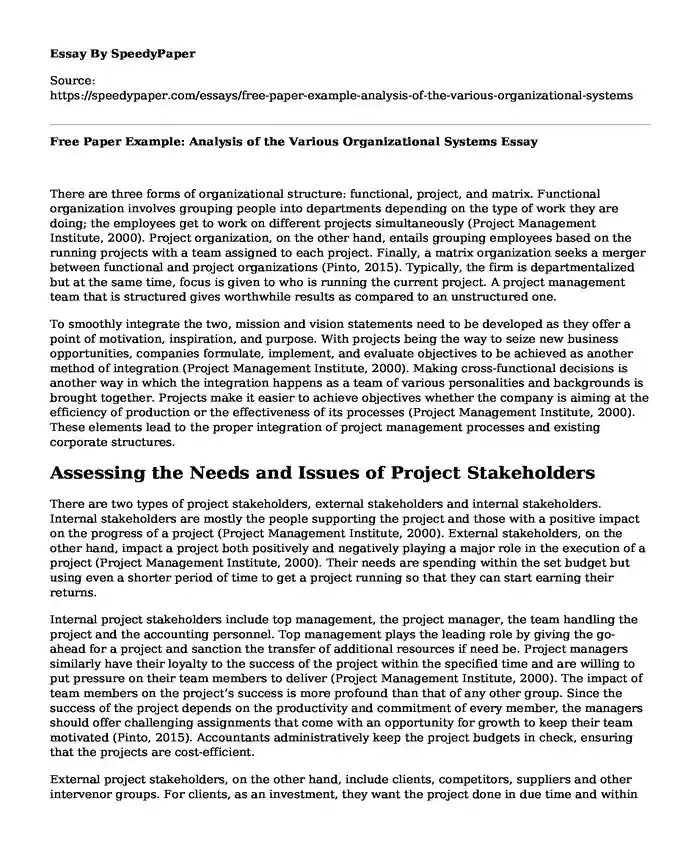
| Essay type: | Analytical essays |
| Categories: | Project management Organizational culture |
| Pages: | 3 |
| Wordcount: | 646 words |
There are three forms of organizational structure: functional, project, and matrix. Functional organization involves grouping people into departments depending on the type of work they are doing; the employees get to work on different projects simultaneously (Project Management Institute, 2000). Project organization, on the other hand, entails grouping employees based on the running projects with a team assigned to each project. Finally, a matrix organization seeks a merger between functional and project organizations (Pinto, 2015). Typically, the firm is departmentalized but at the same time, focus is given to who is running the current project. A project management team that is structured gives worthwhile results as compared to an unstructured one.
To smoothly integrate the two, mission and vision statements need to be developed as they offer a point of motivation, inspiration, and purpose. With projects being the way to seize new business opportunities, companies formulate, implement, and evaluate objectives to be achieved as another method of integration (Project Management Institute, 2000). Making cross-functional decisions is another way in which the integration happens as a team of various personalities and backgrounds is brought together. Projects make it easier to achieve objectives whether the company is aiming at the efficiency of production or the effectiveness of its processes (Project Management Institute, 2000). These elements lead to the proper integration of project management processes and existing corporate structures.
Assessing the Needs and Issues of Project Stakeholders
There are two types of project stakeholders, external stakeholders and internal stakeholders. Internal stakeholders are mostly the people supporting the project and those with a positive impact on the progress of a project (Project Management Institute, 2000). External stakeholders, on the other hand, impact a project both positively and negatively playing a major role in the execution of a project (Project Management Institute, 2000). Their needs are spending within the set budget but using even a shorter period of time to get a project running so that they can start earning their returns.
Internal project stakeholders include top management, the project manager, the team handling the project and the accounting personnel. Top management plays the leading role by giving the go-ahead for a project and sanction the transfer of additional resources if need be. Project managers similarly have their loyalty to the success of the project within the specified time and are willing to put pressure on their team members to deliver (Project Management Institute, 2000). The impact of team members on the project’s success is more profound than that of any other group. Since the success of the project depends on the productivity and commitment of every member, the managers should offer challenging assignments that come with an opportunity for growth to keep their team motivated (Pinto, 2015). Accountants administratively keep the project budgets in check, ensuring that the projects are cost-efficient.
External project stakeholders, on the other hand, include clients, competitors, suppliers and other intervenor groups. For clients, as an investment, they want the project done in due time and within their budget, so they can start generating returns (Pinto, 2015). Competitors, on the other hand, are a source of guidance for a developing project with the manager looking for mistakes made in the established projects (Pinto, 2015). Suppliers offer the raw materials needed for the completion of the project, they are always in constant communication with the project managers on when deliveries should be made and in what quantities. The intervenor groups are external to the project but have the power to disrupt the development of a project. The project manager should always assess the possibility of one intervenor group imposing their concerns on the development of their project.
References
Pinto, J. K. (2015). Project Management. [American Intercontinental University]. Retrieved August 7, 2020, from https://aiu.vitalsource.com/#/books/9780133798241/
Project Management Institute. (2000). A guide to the project management body of knowledge (PMBOK guide) (Vol. 2). Project Management Inst. Retrieved August 7, 2020, from https://aiu.vitalsource.com/#/books/9781628253900/cfi/6/16!/4/2/104/4@0:32.2
Cite this page
Free Paper Example: Analysis of the Various Organizational Systems. (2023, Nov 05). Retrieved from https://speedypaper.com/essays/free-paper-example-analysis-of-the-various-organizational-systems
Request Removal
If you are the original author of this essay and no longer wish to have it published on the SpeedyPaper website, please click below to request its removal:
- Essay Example in IT Project Management
- Essay Sample on Goldman Sachs' Toxic Culture
- Corporate Crisis Management Essay Example
- Essay Example: Reflection and Experiences on Culture and Diversity
- Equity Investing: ROE, P/E, EPS, Current Ratio, Debt/Equity - Essay Sample
- Essay Sample on Rocio Lorenzo: How Diversity Makes Teams More Innovative
- Brain Aneurysm Awareness Walk - Essay Sample
Popular categories




